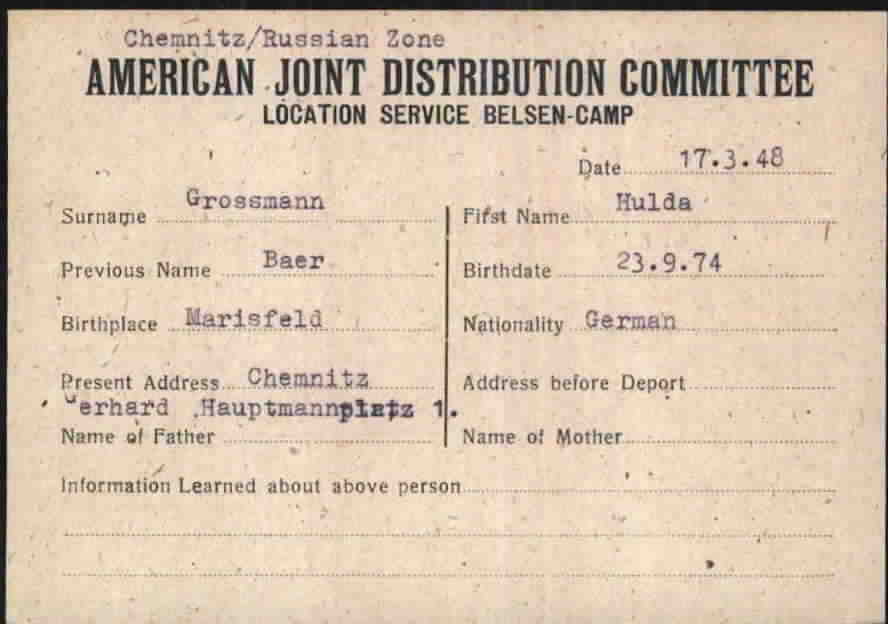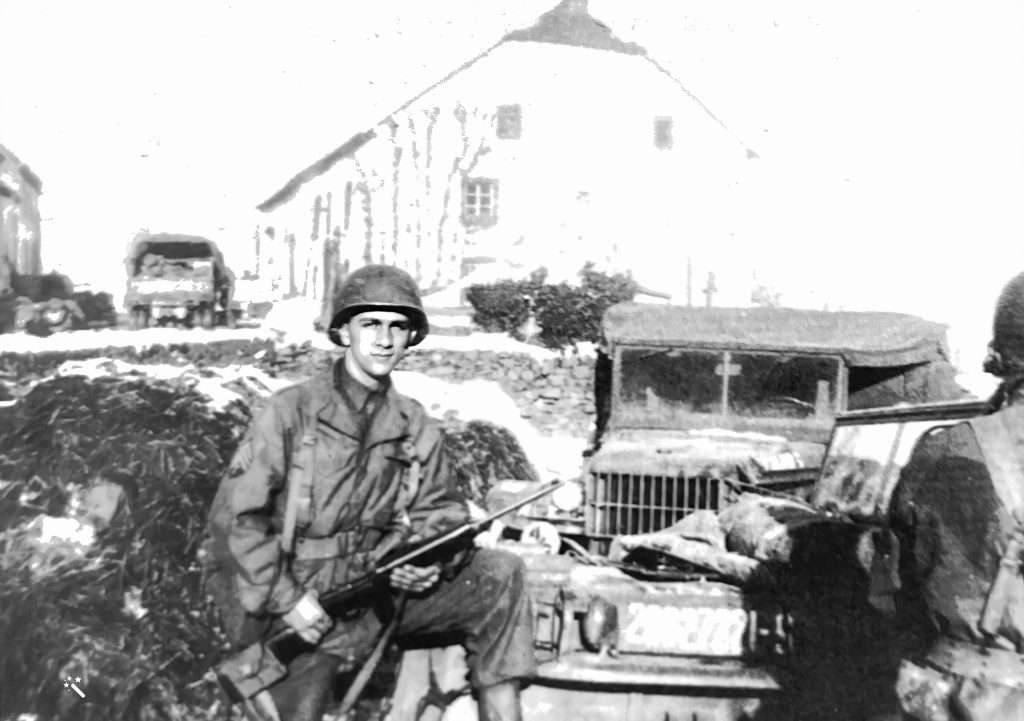
[This page is under construction, thank you for your patience].
08 May 1945: An overview
08 May 1945: the Jews of Themar in Germany
The end of the war in Europe and a Jewish family from Themar
Cornell Hoppe: Themar’s Jewish families and the end of the war in 1945
On May 8, 1945, the Allies (England, France, the United States and Russia) accepted the unconditional surrender of Germany, thus ending the Second World War and the Third Reich.
American soldiers under the command of George Smith Patton had been in the district of Hildburghausen since the beginning of April 1945 and were steadily advancing from north to south. On April 7, 1945, a detachment reached Themar. Among the American soldiers was 21-year-old Ludwig Mühlfelder. Ludwig was the son of Julius Mühlfelder, born in Themar in 1891, a member of the large Frankenberg family, one of the founding families of the Jewish community in Themar. Ludwig left Germany with his parents and his sister Ellen on November 21, 1939, probably unaware that he would return to Germany six years later in a soldier’s uniform.
Ludwig later wrote about this extraordinary event:
On April 8 [1945] we reached Themar in Thuringia, the town of my father’s birth. …
In the last weeks of the war we heard a lot about the discovery of the concentration camps.
It’s hard to imagine what happened there. Thousands and hundreds of thousands were murdered, 6 million Jews. . .
I was grateful to be alive at the end of the war and to be able to help the Allies, especially the United States, in some way to liberate Europe and save some of the remaining Jews.
Because of the Shoah, I cannot forgive the perpetrators, and the
victims remain silent.
But you cannot blame the younger German generation for this terrible chapter that their parents and grandparents caused.
What I expect and demand from the descendants of the perpetrators is a complete
complete reappraisal of the crimes of their people.
At the same time as Ludwig was in Themar, another soldier with a direct connection to Themar was deployed in Hamburg. He was 21-year-old Norbert Müller, a member of the Salamon family and Karoline Müller, who were also one of the founding families of Themar’s Jewish community. At the same age as Ludwig, Norbert had left Germany on the Kindertransport program, enlisted in the British army as quickly as possible, changed his name to Norman Miller and returned to Germany in 1945. (For his story, see “War Ends in Germany: The Story of a Family.”
*****
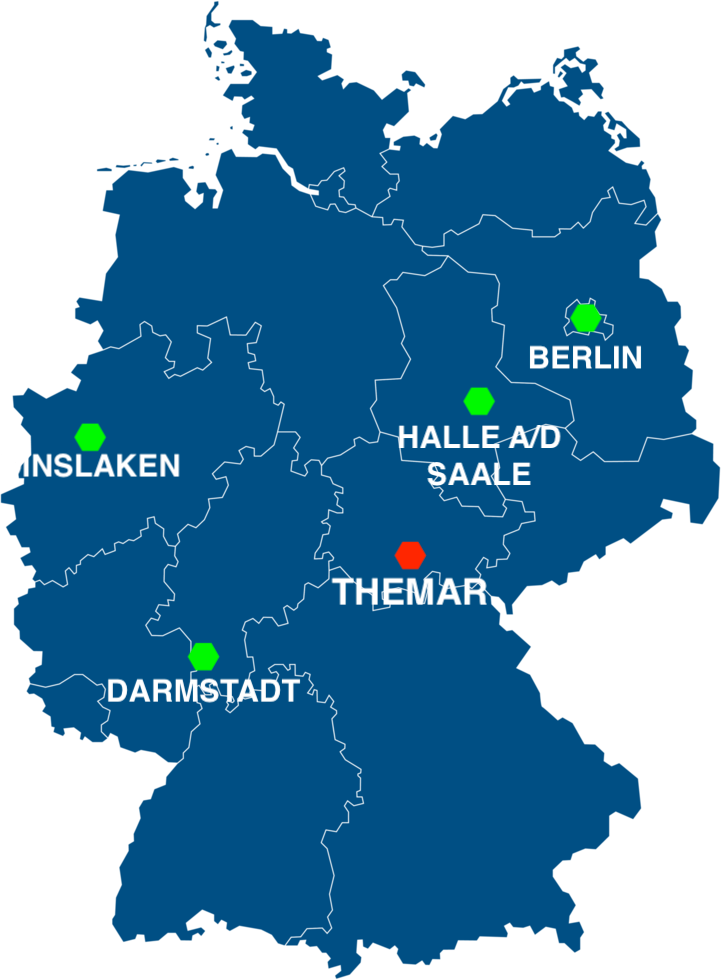 Apart from these two young men, at least 205 members of the Jewish families of Themar were still alive on May 8, 1945, when the war in Europe ended. (The following table lists these 205 men, women and children and where they were on June 8, 1945).
Apart from these two young men, at least 205 members of the Jewish families of Themar were still alive on May 8, 1945, when the war in Europe ended. (The following table lists these 205 men, women and children and where they were on June 8, 1945).
Most of these men, women and children were on continents other than Europe (and especially in the United States), but at least 27 (13%) were in “Germany”, i.e. in Germany within its pre-war borders as well as in occupied Czechoslovakia, where the Theresienstadt ghetto was located.
Those who had survived the war and the Holocaust were probably not particularly aware of the connection to Themar. The last contact they had with Themar had been a bureaucratic one in late December 1938/early January 1939, when all Jews had to add “Israel” or “Sara” to their first names and notify the town’s registrar in writing that they complied with the law. As Themar was behind the Iron Curtain from July 1945, most survivors had little interest in visiting their hometown or that of their parents.
However, the connection to Themar has proven to be hugely important for their descendants. They have found that knowing about their ancestors’ connection to this small town and the surrounding villages fills a gap they didn’t know existed. Since the fall of the Berlin Wall in 1989, a steady stream of descendants have visited Themar, wanting to learn as much as possible about their ancestral history. Much of the information, documents and photos presented here come from the descendants and thus contribute to the shared knowledge.
For historians, genealogists and other researchers, the stories play an important role. Uncovering the complexities and nuances of their individual and intertwined stories broadens the lens through which we can explore and attempt to understand the experiences of a Jewish community. Two soldiers, Ludwig Mühlfelder and Norbert Müller, left Germany at the end of their service. But others stayed. Otto Baer and Meta Krakauer are familiar to most people. Other names are less well known or not known at all: for example Doris Lorenzen, née Frankenberg, born in Themar in 1895. Doris was deported to the Theresienstadt ghetto in 1945 and found her aunt Meta there. After her liberation, Doris took Meta with her to Dinslaken, where the two women spent the rest of their lives. Meta died ten years later, on July 10, 1955, and was buried in the Dinslaken Jewish Cemetery, “the only survivor of a National Socialist ghetto to be buried there.” Doris died in January 1970. Both Meta and Doris are being honored with the reappraisal of Meta’s story (more on this below and under “Searching for traces – one Google at a time!”
This article tells as much as possible about the history of the seven and twenty people.
See also:
May 8, 1945: An overview
The end of the war and the experiences of one family
*****

For a long time, it was assumed that only two Jews from Themar survived – Otto Baer, who survived Auschwitz, and Meta Krakauer, née Frankenberg, who survived the Theresienstadt ghetto. Based on this assumption, it was assumed that there were no Jews in Themar or elsewhere in Germany with a connection to Themar who had survived camps, ghettos or hiding places,
At the time of Ludwig Mühlfelder’s visit, there were Jews living in Themar or nearby, which he was probably unaware of. The twins Johanna and Gunter Haaß, born in Themar in 1928, children of Erna Kahn and Hermann Haaß, a non-Jew, had survived in the care of their father’s relatives. They were now 17 years old. Both stayed in the Themar area after the war. Hanna remained single and worked for the Morgenroth family in Themar; she died in 1968. Gunter became a policeman in East Germany. He married and lived with his wife and two children in a small village near Themar. Gunter died in 1988, shortly before the Wall came down.
Eleven-year-old Ellen Neumann, daughter of Adolf Kahn, lived with her mother and stepfather in Themar. She continued to run her stepfather’s photography business until the 2000s. She died in Themar in 2019.
It is not known how many children of Louis Walther and his non-Jewish wife Olga Zinn lived in Themar, but there may have been four sons, a daughter-in-law and a granddaughter.
Members of the Jewish families of Themar lived elsewhere in Germany; they were either non-Jewish spouses or children of interfaith marriages. Doris Lorenzen’s husband, née Frankenberg, and her son lived in West Germany, in the town of Dinslaken. The family of Siegfried Marcus, eldest son of Emma Marcus, née Gassenheimer, born in Themar in 1863, lived in Halle a/d Saale. While Siegfried was able to flee Germany, his wife Emma Marcus (née Becker) and their three sons Erich, Dieter and Peter were imprisoned in Halle. Erich had suffered badly during forced labor, but survived, while Emma and the younger boys were able to survive in Halle.
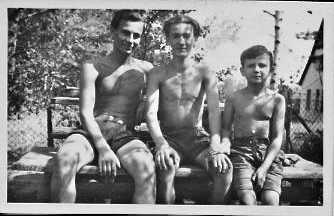
And Else Rosenberg (née Pabst), the wife of Julius Rosenberg (born in Themar in 1910), lived in Darmstadt with her 11-year-old daughter Lotte. After the end of the war, Else contacted the administration in Hilburghausen to find out what had happened to Julius. In the early 1950s, Else and Lotte and Lotte’s husband Peter Schaefer left Germany to live in Canada. Else died in 1965 in Vancouver (British Columbia).
In 2017, Lotte returned to Themar for the first time with her daughter Bianca, her sister Lore and other relatives. Stolpersteine were laid for Lotte’s father Julius Rosenberg, for her grandparents Markus and Else (née Kahn) Rosenberg and for her great-uncle Adolf Kahn, who all lived at Schulstraße 3 (now the site of the Anne Frank School). A Stumbling Stone is to be laid for Lotte in March 2026.
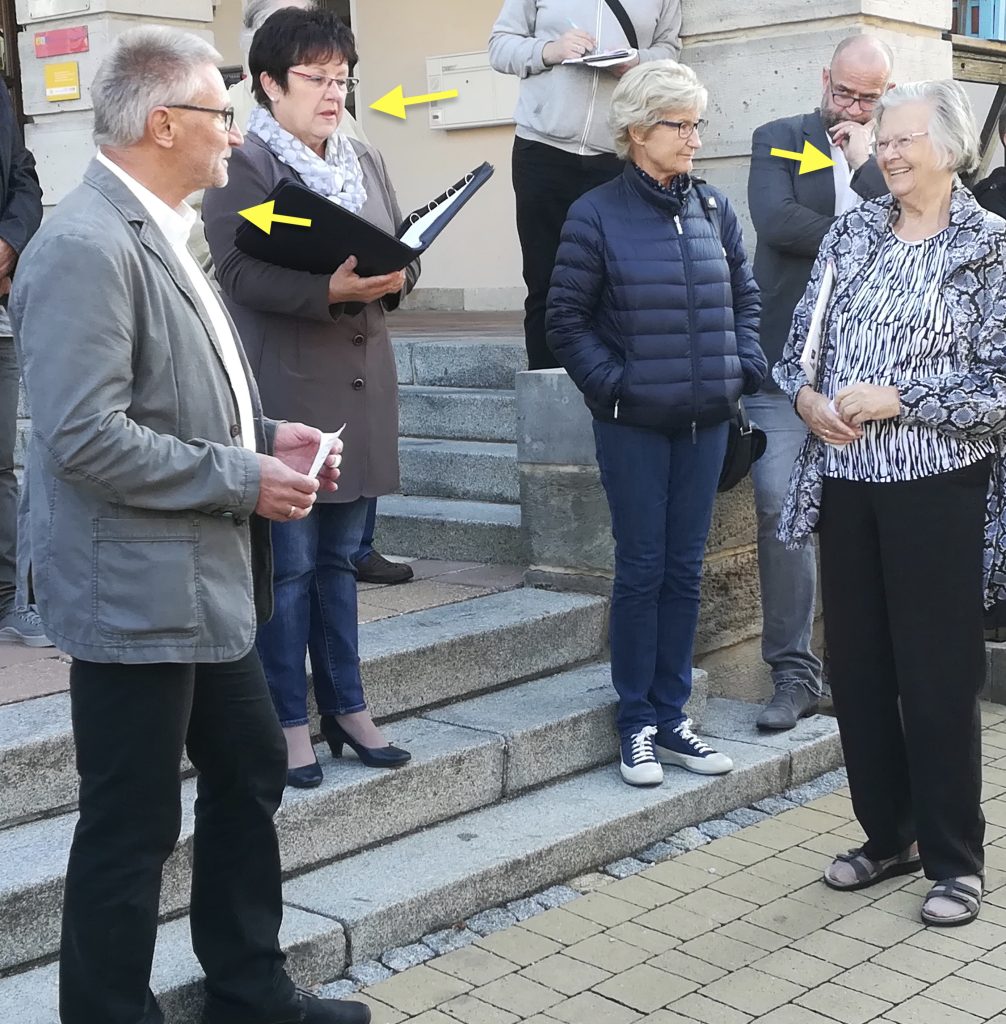
Members of Themar’s Jewish families were in Berlin and the surrounding area at the end of the war. Bella Klöckner, née Frankenberg, born in Themar in 1883, had left Themar sometime after the birth of her daughter Irma in Themar in 1907. Irma Klöckner married Hans Bünning, born in Denmark in 1901, and in the early 1930s they lived in Lübben (in Brandenburg), where son Gernot was born in 1933 and daughter Sigrid in 1934. When the census of the German minority was taken in May 1939, the Bünnings were living in Teltow on the outskirts of Berlin, while Bella and Richard were living in Hanover. The story of their lives during the war is unknown at this time. Irma’s husband Hans died in Berlin on April 25, 1945, shortly before the end of the war. Irma continued to live in Berlin with Gernoth and Sigrid. It is not yet known when Bella and Richard moved to Berlin: Bella died in Berlin-Bukow in 1962 and was buried in the Tempelhof Park Cemetery; Richard had died a few years before her, also in Berlin-Bukow. Sigrid married again (Franz Nietzsch) and remained in Berlin until her death in 1990. Their two children married, but died before their mother: Gernoth died in an accident in 1959, just one year after his marriage; Sigrid died in 1974.
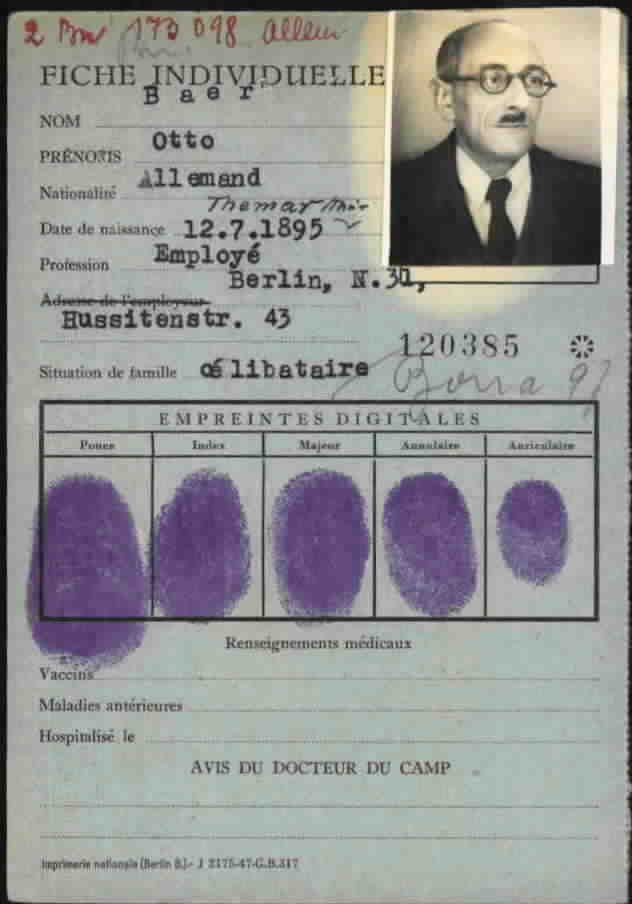 Also in Berlin in May 1945 were the children of Samuel and Lina Baer, born in Themar: Otto, born in 1895 and Klara, born in 1906. Otto Baer was a survivor of Auschwitz. Deported from Berlin to Auschwitz on December 9, 1942, Otto managed to survive in the brutal conditions of the camp for over two years. According to historian Rita Meyhöfer, only he and one other person from the December 9, 1942 transport were still alive on January 27, 1945. Otto Baer was about to turn 50.
Also in Berlin in May 1945 were the children of Samuel and Lina Baer, born in Themar: Otto, born in 1895 and Klara, born in 1906. Otto Baer was a survivor of Auschwitz. Deported from Berlin to Auschwitz on December 9, 1942, Otto managed to survive in the brutal conditions of the camp for over two years. According to historian Rita Meyhöfer, only he and one other person from the December 9, 1942 transport were still alive on January 27, 1945. Otto Baer was about to turn 50.
Sometime after the liberation, the American army found Baer in Zeitz, south of Leipzig. He returned to Berlin and the area in East Berlin where he had previously lived. Aufbau, the New York newspaper that provided the Jewish community with names of victims and survivors, included Otto’s name and address in its November 9, 1945 issue – Otto lived at 43 Hussitenstrasse, a 40-minute walk from his former address. Two years later, the same entry can be found in the list of members of the Jewish Community of Berlin. Otto remained in Berlin for the rest of his life; he did not marry. He died in 1972.
Klara Baer, born in 1906 in Themar, also survived the war and the Holocaust. Her husband, Mordka “Moritz” Mendelwicz, did not; he was murdered in the Mathausen concentration camp shortly before the end of the war, in March 1945. Klara and Mordka’s son, Siegbert, also survived. Klara and Siegbert decided to leave Germany and sailed from Antwerp to New York City in August 1948. Klara and Siegbert Mendelwicz changed their names to Claire and Barry S. Mendell. Claire Mendell died in 1977 and Barry Mendell died in 1991.
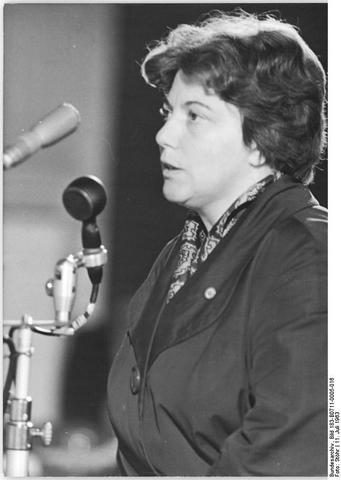 Paula Compart, daughter of Alfred Compart, born in Themar in 1881, was either in Berlin in May 1945 or on her way there. She was also a survivor of Auschwitz, the Theresienstadt ghetto and the Flossenburg concentration camp. On May 28, 1942, Paula’s father, Alfred Compart, was executed in a brutal action at Sachsenhausen concentration camp. Three weeks later, on June 19, 1942, Alfred’s wife Fanny Compart, née Rothmann, and their two children, 18-year-old Paula and 28-year-old Kurt, were deported to the Theresienstadt ghetto. On October 4, 1944, the three were transported to Auschwitz. Fanny was murdered in Auschwitz, probably shortly after her arrival. On October 12, 1944, Paula was transferred from Auschwitz to the Flossenburg concentration camp. In January 1945, as the Red Army approached Auschwitz, Kurt was sent on a death march from Auschwitz to Dachau; he died in the camp on February 2, 1945.
Paula Compart, daughter of Alfred Compart, born in Themar in 1881, was either in Berlin in May 1945 or on her way there. She was also a survivor of Auschwitz, the Theresienstadt ghetto and the Flossenburg concentration camp. On May 28, 1942, Paula’s father, Alfred Compart, was executed in a brutal action at Sachsenhausen concentration camp. Three weeks later, on June 19, 1942, Alfred’s wife Fanny Compart, née Rothmann, and their two children, 18-year-old Paula and 28-year-old Kurt, were deported to the Theresienstadt ghetto. On October 4, 1944, the three were transported to Auschwitz. Fanny was murdered in Auschwitz, probably shortly after her arrival. On October 12, 1944, Paula was transferred from Auschwitz to the Flossenburg concentration camp. In January 1945, as the Red Army approached Auschwitz, Kurt was sent on a death march from Auschwitz to Dachau; he died in the camp on February 2, 1945.
Flossenburg was liberated on April 23, 1945. It is not known exactly when Paula returned to Berlin, but she was married and living in the city in 1950. In 1963 and 1964, she testified in war crimes trials, most notably in the Frankfurt Auschwitz trial in September 1964, when she gave evidence about the brutal murder of her father and her experiences in Auschwitz. She married a total of three times and chose to live in East Berlin under communist rule. She died on October 16, 1979 at the age of 54 and was buried at the Friedrichsfelde Central Cemetery. There were no children from her marriages.
*****
Nine members of the Jewish families of Themar survived the Theresienstadt ghetto.

One of them, Hulda Grünbaum, née Schlesinger, had left Theresienstadt on the “train to freedom” to St. Gallen in Switzerland as part of a last-minute deal between Heinrich Himmler and a Jewish organization. Hulda was later reunited with her daughter Ilse in England, where Ilse had lived since 1939; in 1948, the two women sailed to Australia, where Kurt Grünbaum, son and brother lived.
Both Ilse and Kurt married and had children; Hulda’s grandson Garry Meller has researched his family history thoroughly and contributed a great deal to the history of Themar, Walldorf and Schmalkalden, the ancestral homes of the Grünbaum and Schlesinger families. In 2019, he came to Themar to honor the Grünbaum family by laying Stumbling Stones.

On May 8, 1945, seven women and one man were liberated in the Theresienstadt ghetto: Doris Lorenzen, née Frankenberg; Meta Krakauer, née Frankenberg; Hulda Grossmann, née Bär; Gertrud Heim, née Walther; Rita Dressel, née Walther; Walter Dressel and Margot Dressel; and Minna Frankenberg, née Gassenheimer;
Part of Doris Lorenzen‘s story has been summarized above, but more is known about her complicated history, which sheds light on the experiences of Jewish women married to non-Jewish men. Doris, born in 1898, grew up in Themar with her aunt Meta. After marrying Karl Lorenzen in 1926, she moved west to Dinslaken in North Rhine-Westphalia. They had a son in 1938. The Lorenzen family lived in Dinslaken-Lohberg until July 1942, but were then forcibly relocated to the “Jews’ house” on Weseler Straße.
Doris lost her protected status completely on September 17, 1944, when she was arrested in Dinslaken together with the three other Jewish women married to Christian men in Dinslaken. She was taken with them from Düsseldorf to Minkwitz near Zeitz to do forced labour for the “Organization Todt”. On February 18, 1945, she was deported from Frankfurt am Main to the Theresienstadt ghetto on the train with the transport number XII/10. Doris Lorenzen was given the prisoner number 1210496.
When she found her aunt Meta still alive when the ghetto was liberated, Doris took Meta with her to Dinslaken, where both women spent the rest of their lives. Doris died in January 1970, having converted to Catholicism and was buried in the Catholic cemetery. Her husband Karl predeceased her. Her son Gerd married and remained in Dinslaken until his death in 2019.
Little is known about the other people liberated from Theresienstadt. Gertrud Heim, née Walther, returned to Hildburghausen, but when the town came under communist rule, she moved to West Germany. No further trace was found. Gertrud’s niece Rita Dressel, née Walther, and Rita’s two children also returned to Germany. Rita and her son Walter decided to stay in Germany, while her daughter Margot emigrated to Palestine, which later became Israel. Rita moved to West Germany, where she died in Frankfurt am Main in 1983. Walter lived in Greifswald in East Germany; he died in 2012.
Hulda Grossmann, née Baer, aged 71, returned to Chemnitz, where she had lived for most of her adult life. On March 17, 1948, the American Joint Distribution Committee listed her as living at Gerhard-Hauptmannplatz 1. Some time after this date, Hulda moved to Berlin to live in a Jewish nursing home, where she died on December 26, 1948. It is not known when Hulda learned of the murder of her son Richard and her daughter Elly Stern, née Grossmann, and her granddaughter Hannelore Stern. She knew that Elly and her husband Robert Stern had been deported in May 1942, before she herself was deported to Theresienstadt. She would have hoped that her son Richard Grossmann and her granddaughter Hannelore Stern would have been safe in France. Unfortunately, they were both murdered: Richard on March 25, 1935 in Sobibor and Hannelore in Auschwitz.
******
On the morning of July 4, 1945, two short months after Ludwig Mühlfelder had liberated Themar from National Socialist tyranny, “the inhabitants of Meiningen, which is close to Themar, noticed that the Americans had completely abandoned the town. As the Americans moved in and out, a paralyzing silence fell and the big question arose: What comes next? In the afternoon, the first Red Army units arrived and the Red Army command moved into the place where the American command had previously been located: the Strupp Villa. A new era was dawning, a departure into an uncertain future.
It would be many years before descendants of the Jewish families of Themar, who lived in other parts of the world, would visit the town again.
| CORE FAMILY | NAMES | 08 MAY 1945 | ||
|---|---|---|---|---|
| FAMILY | BIRTH | GIVEN | COUNTRY | |
| BACHMANN | BACHMANN | Sophie | Palestine | |
| BAER | BAER | Otto | Germany | |
| BAER | DAVIDS | Stein | Gerda | USA |
| BAER | DAVIDS | Walter | USA | |
| BAER | GROSSMANN | Bär | Hulda | Theresienstadt |
| BAER | HIRSCH | Stein | Lieselotte | USA |
| BAER | HIRSCH | Hugo | USA | |
| BAER | MENDLEWICZ | Baer | Klara | Germany |
| BAER | MENDLEWICZ | Siegbert | Germany | |
| BAER | PLAUT | Baer | Elly | USA |
| BAER | PLAUT | Arthur | USA | |
| BAER | PLAUT | Hanna Karola | USA | |
| BAER | STERN | Adalbert | Australia | |
| BAER | STERN | Herbert | England | |
| COMPART | COMPART | Paula | Germany | |
| FRANKENBERG | BÜNNING | Kloechner | Irma | Berlin |
| FRANKENBERG | BÜNNING | Sigrid | Berlin | |
| FRANKENBERG | FRANKENBERG | Lothar | Canada | |
| FRANKENBERG | FRANKENBERG | Gassenheimer | Minna | Theresienstadt |
| FRANKENBERG | FRANKENBERG | Mittel | Hedwig | USA |
| FRANKENBERG | FRANKENBERG | Ilse | USA | |
| FRANKENBERG | FRANKENBERG | Heinz | USA | |
| FRANKENBERG | HERZBERGER | Katz | Hilda | Palestine |
| FRANKENBERG | HERZBERGER | Kurt | Palestine | |
| FRANKENBERG | KATZ | Siegmund | Sweden | |
| FRANKENBERG | KLOECHNER | Frankenberg/Wertheimer | Bella | Berlin |
| FRANKENBERG | KLOECHNER | Richard | Berlin | |
| FRANKENBERG | KRAKAUER | Frankenberg | Meta | Theresienstadt |
| FRANKENBERG | LORENZEN | Karl | Germany | |
| FRANKENBERG | LORENZEN | Gerhard | Germany | |
| FRANKENBERG | LORENZEN | Frankenberg | Doris | Theresienstadt |
| FRANKENBERG | MÜHLFELDER | Frank | Hanna | Palestine |
| FRANKENBERG | MÜHLFELDER | Lothar | Palestine | |
| FRANKENBERG | MÜHLFELDER | Ludwig | Themar | |
| FRANKENBERG | MÜHLFELDER | Frank | Minna | USA |
| FRANKENBERG | MÜHLFELDER | Frank | Klara | USA |
| FRANKENBERG | MÜHLFELDER | Julius | USA | |
| FRANKENBERG | MÜHLFELDER | Ellen | USA | |
| FRANKENBERG | MÜHLFELDER | Max | USA | |
| FRANKENBERG | SANDER | Louis | Shanghai | |
| FRANKENBERG | SANDER | Marion | USA | |
| FRIEDMANN | FRIEDMANN | Friedrich | Belgium | |
| FRIEDMANN | FRIEDMANN | Hugo | South Africa | |
| FRIEDMANN | LANG | Friedmann | Johanna | South Africa |
| FRIEDMANN | LANG | Karl | South Africa | |
| FRIEDMANN | LANG | Wilma | South Africa | |
| FRIEDMANN | LANG | Werner | South Africa | |
| GASSENHEIMER | FRIEDMANN | Gassenheimer | Ruth | Brazil |
| GASSENHEIMER | GASSENHEIMER | Herbert | England | |
| GASSENHEIMER | GASSENHEIMER | Siegmund | England | |
| GASSENHEIMER | GASSENHEIMER | Amelie | England | |
| GASSENHEIMER | GASSENHEIMER | Heinz | England | |
| GASSENHEIMER | GASSENHEIMER | Albert | South Africa | |
| GASSENHEIMER | GASSENHEIMER | Peter | South Africa | |
| GASSENHEIMER | GASSENHEIMER | Michael | South Africa | |
| GASSENHEIMER | GASSENHEIMER | Joseph | Johanna | USA |
| GASSENHEIMER | GASSENHEIMER | Julius | USA | |
| GASSENHEIMER | LÜDICKE | Gassenheimer | Ilse | England |
| GASSENHEIMER | LÜDICKE | Herbert | England | |
| GASSENHEIMER | LÜDICKE | Barbara | England | |
| GASSENHEIMER | MARCUS | Becker | Emma | Germany |
| GASSENHEIMER | MARCUS | Dieter | Germany | |
| GASSENHEIMER | MARCUS | Peter | Germany | |
| GASSENHEIMER | MARCUS | Erich | Germany | |
| GASSENHEIMER | MARCUS | Loeb | Hertha | Uruguay |
| GASSENHEIMER | MARCUS | Paul | Uruguay | |
| GASSENHEIMER | MARCUS | Beatrice | Uruguay | |
| GASSENHEIMER | MARCUS | Mendel | Karola | USA |
| GASSENHEIMER | MARCUS | Siegfried | USA | |
| GASSENHEIMER | MARCUS | Erich | USA | |
| GASSENHEIMER | REIS | Siegmund | USA | |
| GASSENHEIMER | REIS | Lore | USA | |
| GASSENHEIMER | REIS | Werner | USA | |
| GASSENHEIMER | ROSENBAUM | Charlotte | Spain | |
| GASSENHEIMER | ROSENBAUM | Walter | Spain | |
| GRÜNBAUM | FERNICH | Grünbaum | Sophie | USA |
| GRÜNBAUM | FERNICH | Frederich | USA | |
| GRÜNBAUM | GRÜNBAUM | Kurt | Australia | |
| GRÜNBAUM | GRÜNBAUM | Ilse | England | |
| GRÜNBAUM | GRÜNBAUM | Hans | Palestine | |
| GRÜNBAUM | GRÜNBAUM | Schlesinger | Hulda | Switzerland |
| GRÜNBAUM | MÜNZER | Seckel | Gertrud | USA |
| GRÜNBAUM | MÜNZER | Alfred | USA | |
| GRÜNBAUM | MÜNZER | Dorothea | USA | |
| GRÜNBAUM | SECKEL | Glassmann | Edith | USA |
| GRÜNBAUM | SECKEL | Heinrich | USA | |
| GRÜNBAUM | SECKEL | Joachim | USA | |
| GRÜNBAUM | SECKEL | Jutta/Elsie | USA | |
| GRÜNBAUM | SOMMER | Grünbaum | Mira | Italy |
| GRÜNBAUM | SOMMER | Arno | Italy | |
| GRÜNBAUM | SOMMER | Sigfried | Italy | |
| GRÜNBAUM | WOHLGEMÜTH | Seckel | Hilda | USA |
| GRÜNBAUM | WOHLGEMÜTH | Max | USA | |
| KAHN | HAASS | Gunter | Germany | |
| KAHN | HAASS | Johanne | Germany | |
| KAHN | KAHN | Julius | Australia | |
| KAHN | NEUMANN | Kahn | Ellen | Themar |
| KAHN | ROSENBERG | Miriam | England | |
| KAHN | ROSENBERG | Lotte | Germany | |
| KAHN | ROSENBERG | Else | Germany | |
| KAHN | ROSENBERG | Elly | USA | |
| KATZ | Katz | Walter | England | |
| KATZ | KATZ | Fritz | USA | |
| MAYER/ MÜLLER | MÜLLER | Wolf | Flora | USA |
| MAYER | LEVINSTEIN | Mayer | Nanett | USA |
| MAYER | LEVINSTEIN | Heinrich | USA | |
| MAYER/ MÜLLER | MÜLLER | Herbert | USA | |
| MAYER/ MÜLLER | MÜLLER | Helen | USA | |
| MAYER | WOLF | Mayer | Frieda | USA |
| MAYER | WOLF | Albert | USA | |
| MÜLLER | AMRAM | Sitta | USA | |
| MÜLLER | AMRAM | Meinhardt | USA | |
| MÜLLER | AMRAM | Manfred | USA | |
| MÜLLER | DRESSEL | Walther | Rita | |
| MÜLLER | DRESSEL | Walter | ||
| MÜLLER | FRIEDMANN | Müller | Margarete | England |
| MÜLLER | FRIEDMANN | Lothar | England | |
| MÜLLER | HÄUSLER | Rapp | Rosa | USA |
| MÜLLER | HÄUSLER | Frank | Paula | USA |
| MÜLLER | HÄUSLER | Erich | USA | |
| MÜLLER | HÄUSLER | Fritz | USA | |
| MÜLLER | HÄUSLER | Giesela | USA | |
| MÜLLER | HÄUSLER | Erich | USA | |
| MÜLLER | HÄUSLER | USA | ||
| MÜLLER | HEIM | Gertrud | Theresienstadt | |
| MÜLLER | MEYER | Müller | Karola | Australia |
| MÜLLER | MEYER | Gerhard | Australia | |
| MÜLLER | MEYER | Ruth | Australia | |
| MÜLLER | MÜLLER | Vollmann | Martha | Argentina |
| MÜLLER | MÜLLER | Albert | Argentina | |
| MÜLLER | MÜLLER | Margot | Argentina | |
| MÜLLER | MÜLLER | Hans | Argentina | |
| MÜLLER | MÜLLER | Willi | Palestine | |
| MÜLLER | MÜLLER | Grünbaum | Recha | Shanghai |
| MÜLLER | MÜLLER | Karl | Shanghai | |
| MÜLLER | MÜLLER | Julius | Sweden | |
| MÜLLER | MÜLLER | Meinhold | Sweden | |
| MÜLLER | MÜLLER | Martin | USA | |
| MÜLLER | MÜLLER | Kahn | Mary | USA |
| MÜLLER | MÜLLER | S. | USA | |
| MÜLLER | MÜLLER | Sebald | Netherlands | |
| MÜLLER | MÜLLER | Heinemann | Hertha | Netherlands |
| MÜLLER | MÜLLER | Ursula | Netherlands | |
| MÜLLER | MÜLLER | Norbert | England | |
| MÜLLER | NEUMANN | Erich | USA | |
| MÜLLER | SÜSSMANN | Walther | Recha | Germany |
| SACHS | FRIEDMANN | Sachs | Elsa | USA |
| SACHS | FRIEDMANN | Julius | USA | |
| SACHS | KLEEMANN | Sachs | Anna | Shanghai |
| SACHS | KLEEMANN | Harry | Shanghai | |
| SACHS | SACHS | Moritz | Shanghai | |
| SACHS | SACHS | Feodor | Shanghai | |
| SACHS | SACHS | Robert | Shanghai | |
| SACHS | SACHS | Hilde | South Africa | |
| SACHS | SACHS | Rindsberg | Helene | USA |
| SACHS | SACHS | Felix | USA | |
| SACHS | SACHS | Albert | USA | |
| SACHS | SACHS | Alkan | Rosita | USA |
| SACHS | SACHS | Hans | USA | |
| SCHWAB | ROSENGARTEN | Schwab | Bertha | Shanghai |
| SCHWAB | ROSENGARTEN | Paul | Shanghai | |
| SCHWAB | ROSENGARTEN | Manfred | Shanghai | |
| SCHWAB | ROSENGARTEN | Erich | Shanghai | |
| SCHWAB | SCHWAB | Steindler | Frieda | Shanghai |
| SCHWAB | SCHWAB | Oskar | Shanghai | |
| WALTHER | LÜBECK | Walther | Wera | Palestine |
| WALTHER | LÜBECK | Gustav | Palestine | |
| WALTHER | LÜBECK | Amos | Palestine | |
| WALTHER | WALTHER | Otto | Themar? | |
| WALTHER | WALTHER | Alma | Themar? | |
| WALTHER | WALTHER | Sauerby | Helga | Themar? |
| WALTHER | WALTHER | Willi | Themar? | |
| WALTHER | WALTHER | Ernst | Themar? | |
| WALTHER | WALTHER | Erich | Themar? | |
| WERTHEIMER | GLASER | Siegfried | USA | |
| WERTHEIMER | GLASER | Marianne | USA | |
| WERTHEIMER | KLIPSTEIN | Wertheimer | Irma | USA |
| WERTHEIMER | KLIPSTEIN | Leo | USA | |
| WERTHEIMER | KLIPSTEIN | Janine | USA | |
| WERTHEIMER | KOLODZINSKI | Wertheimer | Hanna | Argentina |
| WERTHEIMER | KOLODZINSKI | Rudolf | Argentina | |
| WERTHEIMER | KOLODZINSKI | Ruth | Argentina | |
| WERTHEIMER | KOLODZINSKI | Wertheimer | Käte | Argentina |
| WERTHEIMER | KOLODZINSKI | Franz | Argentina | |
| WERTHEIMER | MEDER | Wertheimer | Lotte | Netherlands |
| WERTHEIMER | MEDER | Edwin | Netherlands | |
| WERTHEIMER | MEDER | Siegbert | Netherlands | |
| WERTHEIMER | WASSERMANN | Wertheimer | Charlotte | Uruguay |
| WERTHEIMER | WASSERMANN | Adolf | Uruguay | |
| WERTHEIMER | WASSERMANN | Hans | Uruguay | |
| WERTHEIMER | WASSERMANN | Ursula | Uruguay | |
| WERTHEIMER | WERTHEIMER | Frankenberg | Else | Argentina |
| WERTHEIMER | WERTHEIMER | Nathan | Argentina | |
| WERTHEIMER | WERTHEIMER | Edith | Argentina | |
| WERTHEIMER | WERTHEIMER | Julius | USA | |
| WERTHEIMER | WERTHEIMER | Käthe | USA | |
| WERTHEIMER | WERTHEIMER | Heinz | USA | |
| WERTHEIMER | WERTHEIMER | Alfred | USA | |
| WERTHEIMER | WERTHEIMER | Mahlendorf | Louise-Marthe | Netherlands |
| WERTHEIMER | WERTHEIMER | Alfred | USA | |
| WERTHEIMER | WERTHEIMER | Warner | Marion | USA |
| WERTHEIMER | WERTHEIMER | Edgar | USA | |
| WERTHEIMER | WERTHEIMER | Shapiro | Roslyn | USA |
| WERTHEIMER | WERTHEIMER | Lindenfeld | Rosalie | ? |
| WERTHEIMER | WERTHEIMER | Lamm | Helene | Netherlands |
NOTES:
1. as elsewhere on this website, a member of a Jewish family in Themar is defined as someone related to the 15 nuclear families, i.e. spouses and descendants of a person with a direct connection to Themar. These people do not have to have been born in Themar. For example, Ludwig Mühlfelder was born in Suhl, but was the son of Julius Mühlfelder, who was born in Themar. The figure does not include relatives of a spouse who was not born in Themar, e.g. relatives of Minna Frank, born in Bavaria, the wife of Julius Mühlfelder.
2 Although the Compart family is not one of the central founding families of Themar (because the family only lived in the small town for about 5 years), the fate of the family has been included in this overview.


